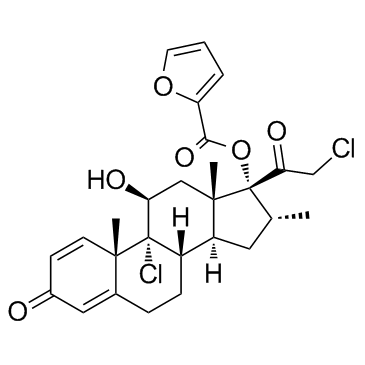Mometasone furoate

Mometasone furoate structure
|
Common Name | Mometasone furoate | ||
|---|---|---|---|---|
| CAS Number | 83919-23-7 | Molecular Weight | 521.43 | |
| Density | 1.4±0.1 g/cm3 | Boiling Point | 655.5±55.0 °C at 760 mmHg | |
| Molecular Formula | C27H30Cl2O6 | Melting Point | 218-220°C | |
| MSDS | Chinese USA | Flash Point | 350.2±31.5 °C | |
|
Mometasone furoate hydrogel for scalp use: in vitro and in vivo evaluation.
Pharm. Dev. Technol. 19(5) , 618-22, (2014) Dermatological inflammatory diseases often affect the scalp and the eyebrows. Common dosage forms available on the market for those situations are lotions; however, the presence of hair limits their use. Gels, for their consistency and adhesiveness, are a sui... |
|
|
Hypothalamic-pituitary-adrenal axis effects of mometasone furoate/formoterol fumarate vs fluticasone propionate/salmeterol administered through metered-dose inhaler.
Chest 144(6) , 1795-802, (2013) The effects of mometasone furoate and fluticasone propionate on the hypothalamic-pituitary-adrenal axis were compared when administered from combination metered-dose inhaler (MDI) products.In a randomized, open-label, placebo-controlled, parallel group study,... |
|
|
Neuropathic dermatitis after flap surgery.
J. Plast. Reconstr. Aesthet. Surg. 67(7) , 1013-5, (2014)
|
|
|
The glucocorticoid mometasone furoate is a novel FXR ligand that decreases inflammatory but not metabolic gene expression.
Sci. Rep. 5 , 14086, (2015) The Farnesoid X receptor (FXR) regulates bile salt, glucose and cholesterol homeostasis by binding to DNA response elements, thereby activating gene expression (direct transactivation). FXR also inhibits the immune response via tethering to NF-κB (tethering t... |
|
|
Inhibition of chlorine-induced pulmonary inflammation and edema by mometasone and budesonide.
Toxicol. Appl. Pharmacol. 272(2) , 408-13, (2013) Chlorine gas is a widely used industrial compound that is highly toxic by inhalation and is considered a chemical threat agent. Inhalation of high levels of chlorine results in acute lung injury characterized by pneumonitis, pulmonary edema, and decrements in... |
|
|
Corticosteroids found ineffective for phosgene-induced acute lung injury in rats.
Toxicol. Lett. 229(1) , 85-92, (2014) Various therapeutic regimes have been proposed with limited success for treatment of phosgene-induced acute lung injury (P-ALI). Corticoids were shown to be efficacious against chlorine-induced lung injury but there is still controversy whether this applies a... |
|
|
Cost-effectiveness analysis of mometasone furoate versus beclomethasone dipropionate for the treatment of pediatric allergic rhinitis in Colombia.
Adv. Ther. 32(3) , 254-69, (2015) Allergic rhinitis (AR) is one of the most common chronic respiratory diseases observed in the pediatric population, producing a significant morbidity, and an economic burden due to direct medical costs and indirect costs. Despite the high prevalence of AR in ... |
|
|
Topical corticosteroids do not revert the activated phenotype of eosinophils in eosinophilic esophagitis but decrease surface levels of CD18 resulting in diminished adherence to ICAM-1, ICAM-2, and endothelial cells.
Inflammation 37(6) , 1932-44, (2014) Swallowed topical corticosteroids are the standard therapy for eosinophilic esophagitis (EoE) in adults. Eosinophils in the blood of untreated EoE patients have an activated phenotype. Our aim was to determine if corticosteroids restore the phenotype of eosin... |
|
|
Comparison of Moisturizing Creams for the Prevention of Atopic Dermatitis Relapse: A Randomized Double-blind Controlled Multicentre Clinical Trial.
Acta Derm. Venereol. 95 , 587-92, (2015) Atopic dermatitis (AD) affects adults and children and has a negative impact on quality of life. The present multicentre randomized double-blind controlled trial showed a barrier-improving cream (5% urea) to be superior to a reference cream in preventing ecze... |
|
|
Comparison of nasal steroid with antihistamine in prophylactic treatment against pollinosis using an environmental challenge chamber.
Allergy Asthma Proc. 33(5) , 397-403, (2012) Environmental challenge chambers (ECC) have been used to expose people to pollen allergens within a stable atmosphere and to examine the efficacy of treatment. Although pollinosis is one of the typical IgE-mediated type I allergic diseases, allergic inflammat... |